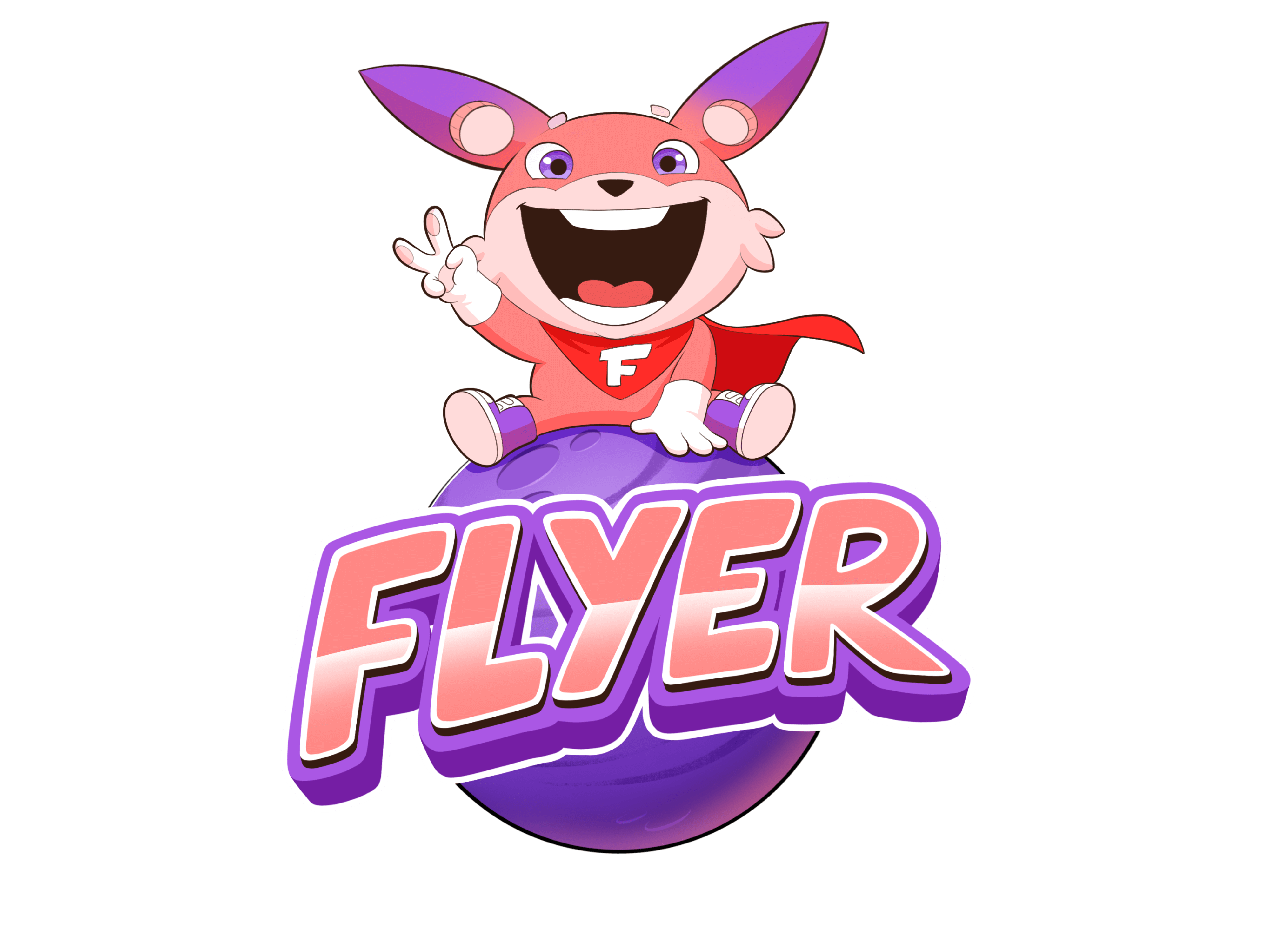Inquiry Based Teaching and Learning (IBL) is a teaching method that encourages students to learn through inquiry, curiosity, and guided discovery. This allows teachers to reduce workload while still supporting effective student learning. With four levels of implementation, IBL works across different age groups and proficiency levels.
In this article, FLYER shares practical tips and steps to bring IBL into daily English lessons. Start exploring now!
1. What is Inquiry Based Teaching and Learning?
Inquiry-Based Teaching and Learning (IBL) is a learner-centered approach that focuses on exploration and problem-solving.
In an IBL classroom, teachers introduce a guiding question to spark curiosity, then let students actively investigate and discover answers on their own. This means learners take ownership of the entire journey, from exploring information to making decisions.
Example:
- Topic: Food and Culture – Grade 6
- Inquiry question: “Why do people eat different foods in different countries?”
- Students explore international menus, compare eating habits, and create a short English presentation connecting food to culture or climate.
Rooted in constructivist and experiential learning theories, IBL encourages learners to explore topics they are genuinely curious about while developing their skills, making learning more meaningful and practical.
IBL is a flexible method that can be adapted to different student groups, subjects, curricula, and learning models. This article, however, will focus on IBL in English classes for young learners.
2. Why Choose Inquiry Based Education?
After exploring the basics of Inquiry Based Teaching, one important question remains: Could this be a teaching approach worth trying? Here are five key benefits that IBL can offer to English teachers and learners.
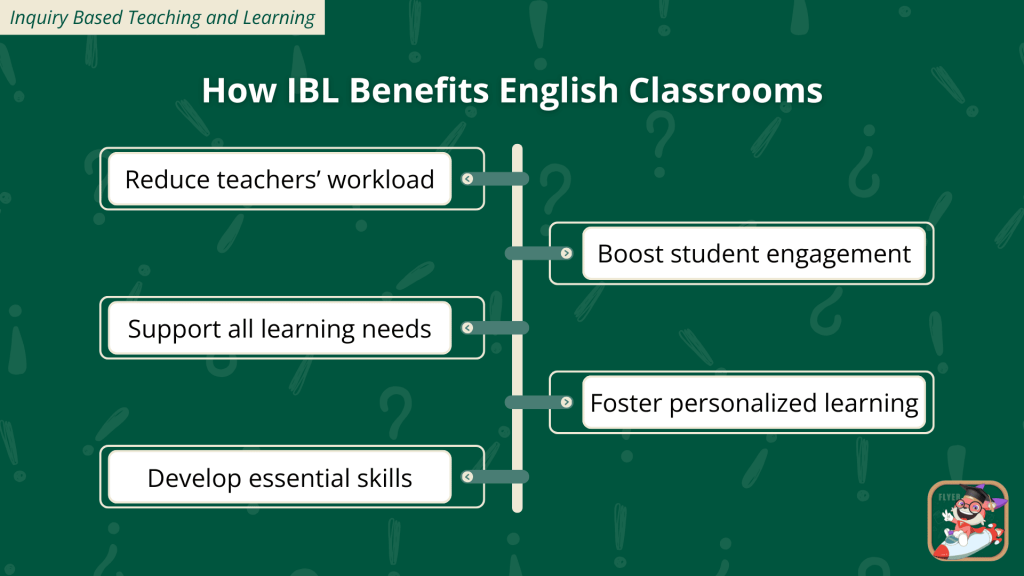
- Reducing teachers’ workload by letting students take on part of the learning process, such as exploring vocabulary, researching topics, or presenting findings instead of teachers explaining everything.
- Boosting student engagement through autonomy and active participation.
- Supporting diverse learning needs with flexible activities for different abilities, including students with reading or writing difficulties, ADHD, or other learning differences.
- Encouraging personalized learning by offering varied tasks that match students’ skills, interests, and preferences.
- Developing essential skills such as critical thinking, problem-solving, creativity, communication, and social interaction.
IBL encourages a move toward deeper student engagement and more meaningful learning experiences. However, its effectiveness depends on how well it aligns with the class’s readiness and capacity to adapt. Because IBL marks a clear break from traditional methods that have shaped student learning for decades, transitioning to this approach requires time, planning, and support.
3. Step-by-Step Guide to Implement IBL in Classrooms
In practice, IBL method can take many forms. It might be a short-term activity within one lesson or a long-term project spanning several weeks. Depending on the learning goals, tasks can be designed for individuals, pairs, small groups, or the entire class. The steps below outline how to bring IBL into the English teaching context in a clear and manageable way.
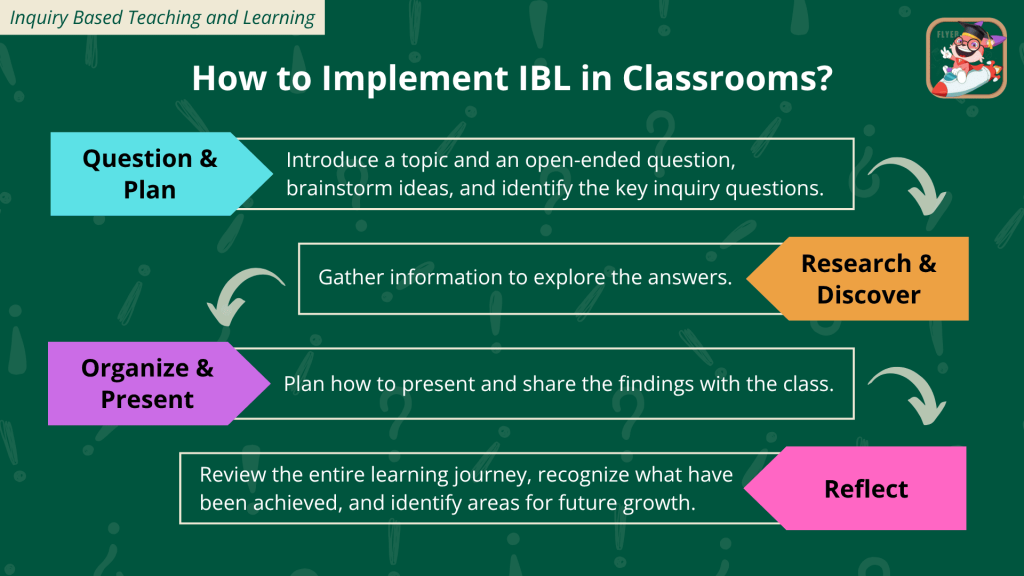
3.1. Question & Plan
The first step is to introduce a topic, pose an open-ended question, and ask students to brainstorm ideas by connecting to their prior knowledge. Revisiting familiar topics from a new angle can spark curiosity and inspire students to explore the subject with greater enthusiasm.
To help students explore possible answers, teachers can break down a big question into smaller guiding questions. An inquiry wall or poster can also be used to collect questions and ideas, encouraging students to contribute their own.
This process helps identify what students already know, what they are curious about, and the key inquiry questions to focus on in the next stages.
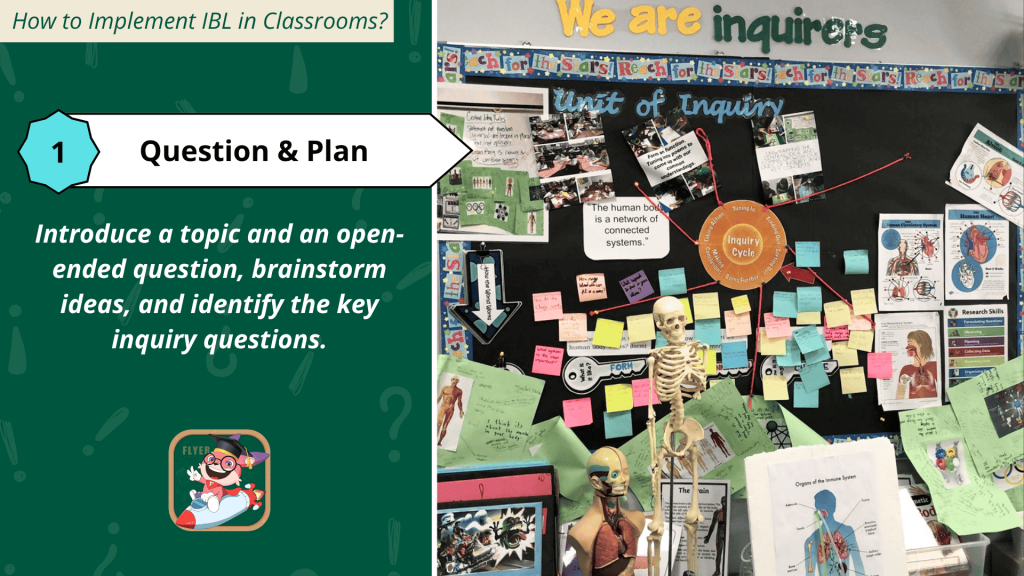
3.2. Research & Discover
Once the key question is set, students start gathering information to explore the answers. This can be done in class or at home through reading books, checking reliable websites, watching educational videos, using AI tools, etc. Surveys, interviews, guest speakers, and even field trips are great ways to collect real-world insights.
For beginners, teachers should guide students in choosing suitable sources, keeping materials manageable, and noting down information with proper citations.
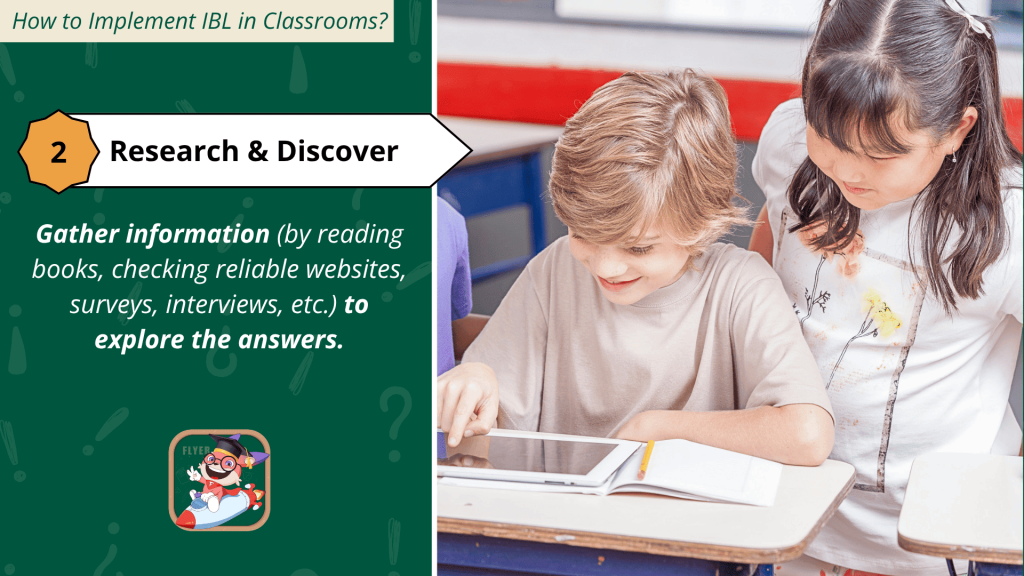
3.3. Organize & Present
After students have gathered enough information, they plan how to present and share their findings with the class.
For first-time presenters, teachers can guide them to organize content logically, focus on key points, and use visuals effectively. Presentations may take various forms, such as posters, short plays, mini books, or even simple documentary videos.
Furthermore, a brief feedback session at the end helps students improve and build confidence for their next IBL project.
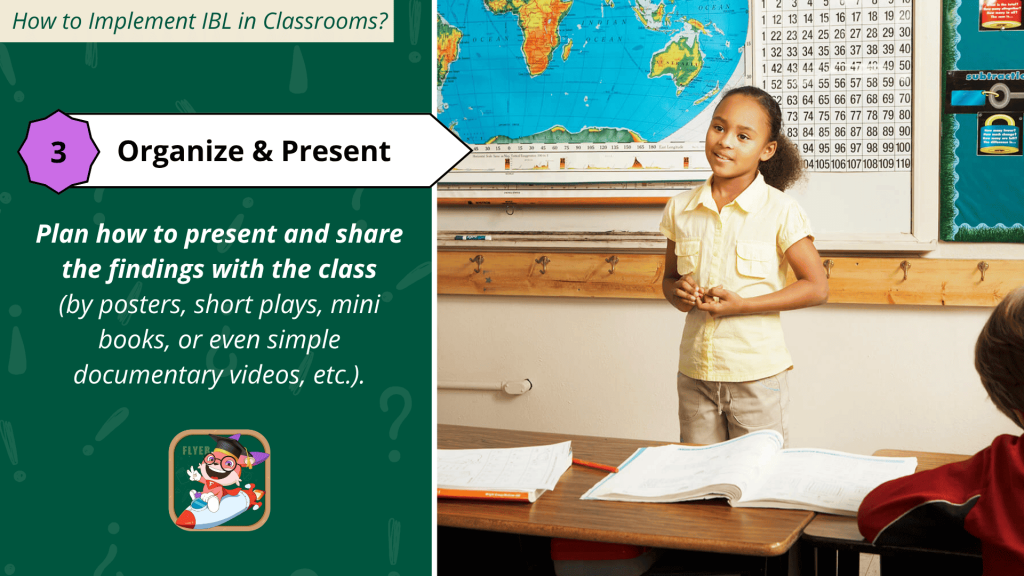
3.4. Reflect
The last step in Inquiry Based Teaching and Learning focuses on student self-reflection. This stage allows learners to review their entire learning journey, recognize what they have achieved, and identify areas for future growth. Guiding questions can include:
- What did I know and not know before starting the project?
- What are the most important or interesting things I learned?
- What do I still need to explore or improve?
- How do I evaluate my own performance on this project (e.g., using a 1-10 scale)?
- If I could redo the project, what would I do differently?
- What is the next step, continue with the main inquiry question or explore a new aspect?
Creating a safe environment for sharing successes and challenges helps students track their growth and develop clear learning goals for the future.
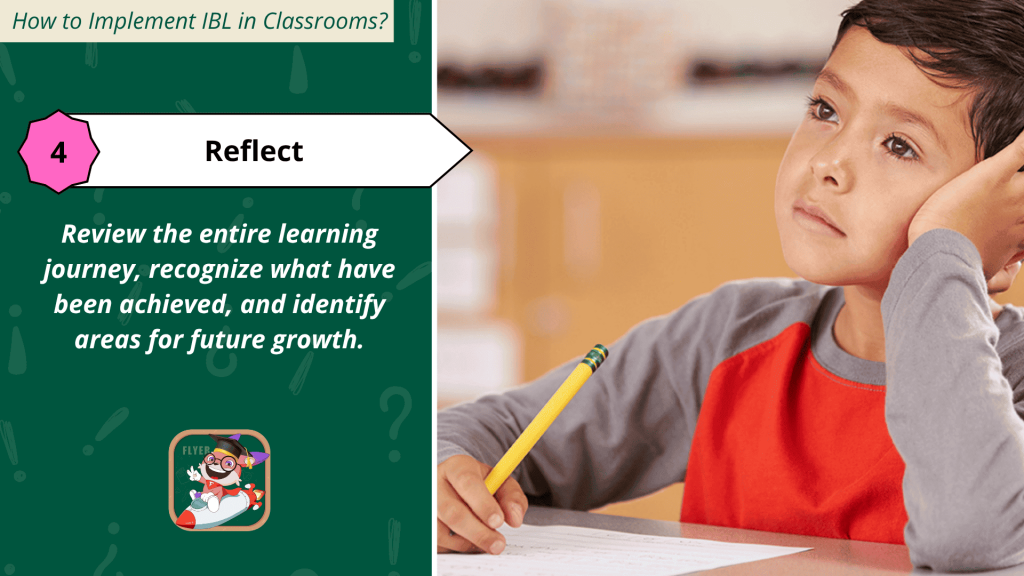
4. 4 Key Levels of IBL for Effective English Teaching
IBL is categorized into four progressive levels, starting from the most basic level for beginners and gradually increasing in complexity for learners who are more experienced with the method. These levels are:
| Levels of IBL | Teachers provide students with | Best for | Student autonomy |
|---|---|---|---|
| Controlled/ Confirmation | – Guiding questions to spark curiosity. – Step-by-step instructions. – Clear expectations for the final outcome. – Support and guidance whenever needed. | Students who are new to IBL or need to strengthen their basic knowledge. | Very low |
| Structured | – Guiding questions. – Step‑by‑step instructions. – Support when needed. | Students starting to explore IBL with some teachers’ guidance, but not full control like in Controlled Inquiry. | Low to Moderate |
| Guided | – Guiding questions. – Support when needed. | Students already familiar with IBL and able to organize their learning process. | Moderate to High |
| Open | Support when needed. | Students who have mastered IBL and can explore and research topics on their own effectively. | Very high |
Below are the details and practical examples of how to use each type of IBL in a young learners’ English class, illustrated with the lesson topic “Investigating a Mystery Fruit.”
4.1. Controlled Inquiry/ Confirmation Inquiry
Controlled/ Confirmation Inquiry is the most basic level of Inquiry Based Learning. In this stage, teachers provide guiding questions and give clear instructions on the process, method to follow, and expected outcome. Students carry out the tasks step by step to confirm the known result.
Example:
- Guiding question: “Is this fruit sweet or sour?”
- Process: Teachers prepare small pieces of fruit and a step-by-step instruction sheet with sample answers. For example: taste → “Sweet!”; touch → “It is smooth.”
- Students’ role: Students follow the instructions, record their findings using the target vocabulary or structures, and confirm the result: “This fruit is sweet.”
- Key feature: Students follow a clear procedure to reach the result that is already known, focusing on practicing skills and learning the process.
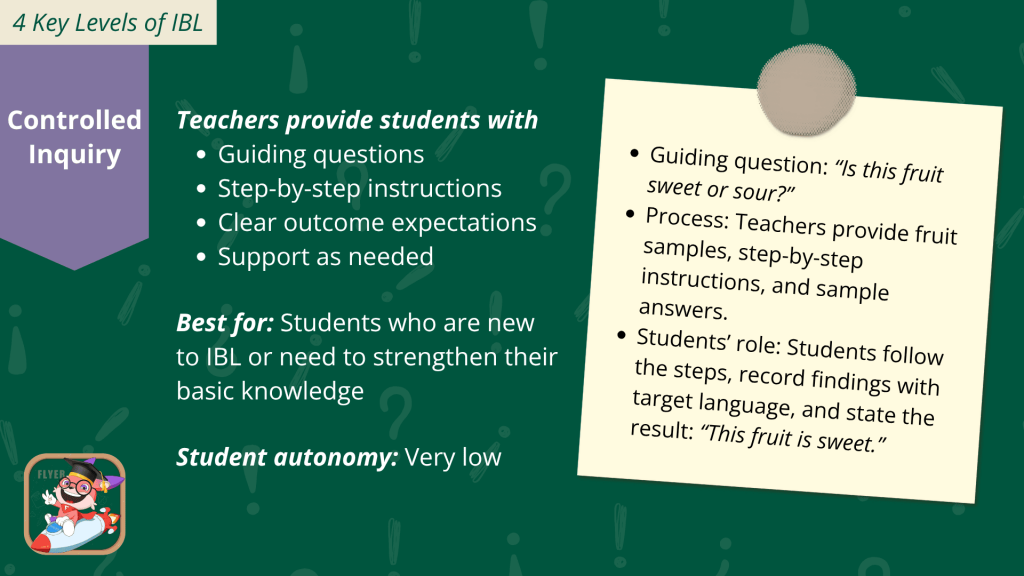
4.2. Structured Inquiry
Similar to Controlled Inquiry, teachers provide guiding questions and step-by-step instructions. However, in Structured Inquiry, students are not told what final outcome should be. They simply follow the process and methods suggested by teachers to investigate and discover the answer on their own.
Example:
- Guiding question: “What taste and texture does this fruit have?”
- Process: Teachers give step-by-step instructions (taste, smell, look) but do not reveal the result in advance.
- Students’ role: Follow the process, then write their own conclusion, such as: “It is sweet and smooth.”
- Key feature: Students do not know the answer beforehand. They explore and reach conclusions by following the teacher’s structured guidance.
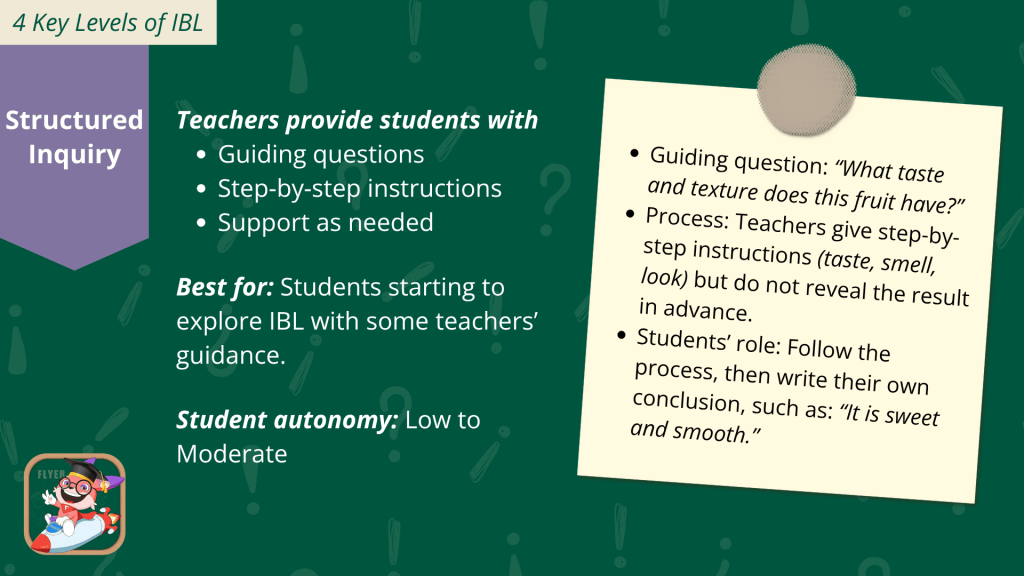
4.3. Guided Inquiry
In Guided Inquiry, teachers provide only a broad question or topic but do not guide how students should find the answer. Students are responsible for creating the entire learning process, from choosing appropriate methods, investigating and collecting data, to presenting a final conclusion and discussing their findings.
Example:
- Guiding question: “What kind of fruit is this, and how would you describe it in English?”
- Process: Teachers offer an open-ended question without suggesting any method.
- Students’ role: Students decide how to explore. They might taste the fruit, observe its color and shape, check a dictionary, ask classmates, take notes, and finally draw conclusions about its name, characteristics, and description in English before sharing with the class.
- Key feature: Students design their own learning process, select methods that work best for them, self-adjust along the way, and present the results.
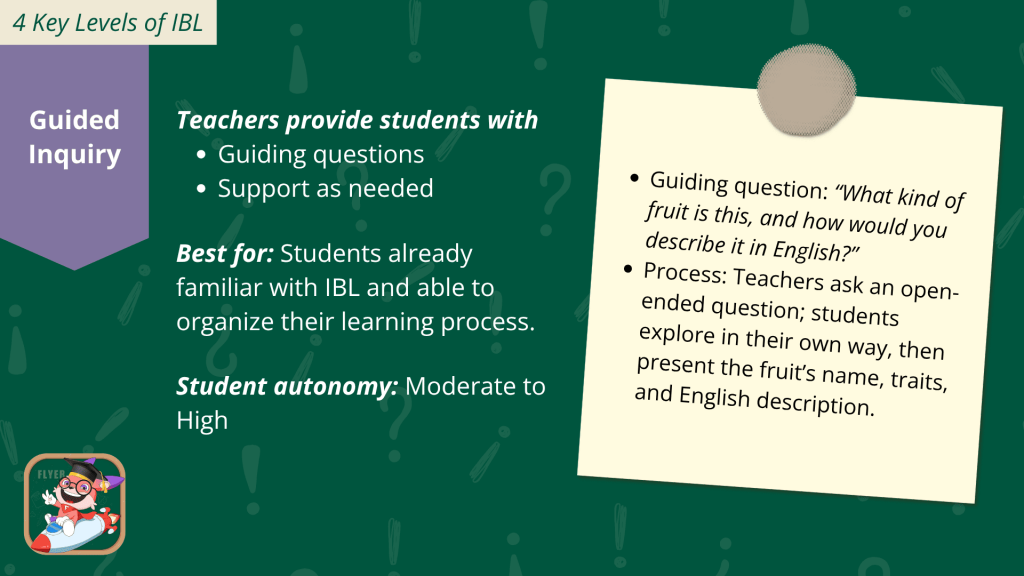
4.4. Open Inquiry
Open Inquiry requires a much higher level of learner autonomy compared to other types of IBL. In Open Inquiry, students take full ownership of their learning, including the process of asking questions. This means they create their own questions and explore the answers independently, while teachers step back into a supportive role.
Example:
- Students may ask themselves, “Why do fruits have different tastes?” or “Can we invent a new fruit flavor?”
- Process and student role: Learners decide on the questions, choose how to investigate, collect data, analyze findings, and share results.
- Teachers’ role: Teachers only provide technical support when necessary, such as helping with vocabulary or giving advice on practical steps, without directing the methods or learning goals.
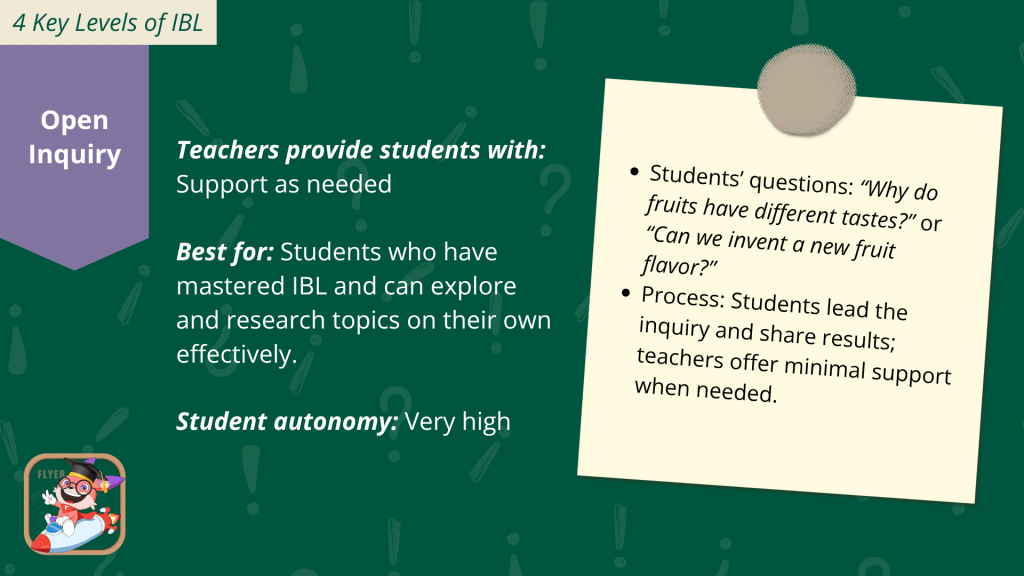
5. Sample Lesson Plan Using IBL in an English class
To illustrate how IBL can be implemented in an English classroom, the sample lesson plan below showcases a practical approach using Guided Inquiry. The file is available for download and can be tailored to meet different teaching contexts.
6. Challenges of Implementing IBL and Solutions
While implementing IBL method in the classroom, teachers may face a range of challenges, both internal and external. Below are some of the most common difficulties, along with practical suggestions to help ensure better preparation before bringing IBL into lessons.
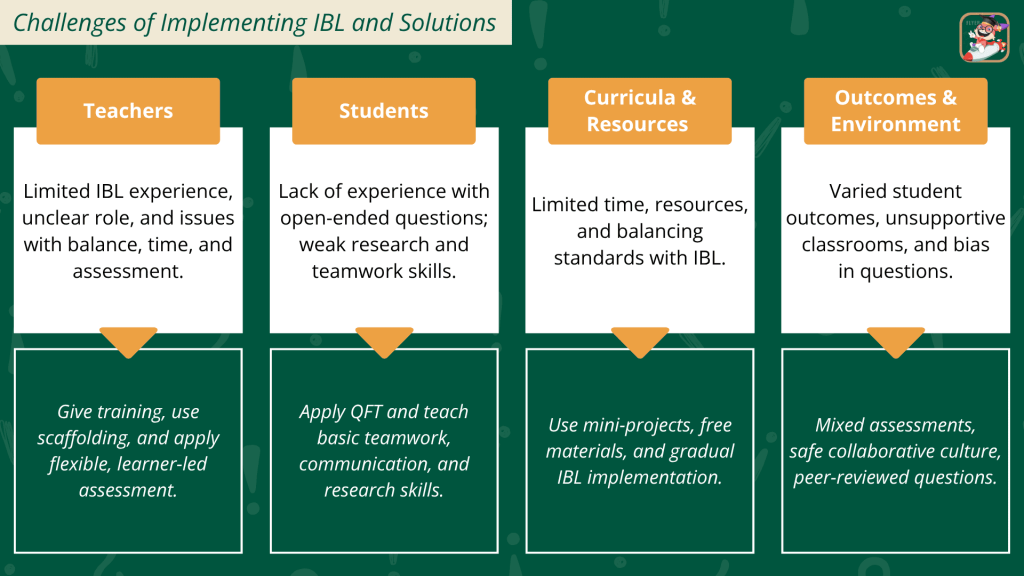
| Related to | Challenges | Practical Solutions |
|---|---|---|
| Teachers | – Limited IBL experience and uncertainty about the facilitator role. – Difficulty balancing guidance with student autonomy. – Time management and flexible assessment remain challenging. | – Offer regular training, mentoring, and teacher networks to exchange IBL strategies. – Use scaffolding effectively, reducing support as learners gain independence. – Include mini-lessons, flexible rubrics, and peer/ self-assessment. |
| Students | – Unfamiliar with open-ended questions, making them feel confused or disengaged, especially if the topic does not spark their interest. – Limited research and teamwork skills. | – Introduce the Question Formulation Technique (QFT) to help students practice generating and refining their own questions. – Incorporate short mini-lessons that teach basic skills for teamwork, communication, and small-scale research. |
| Curricula and Resources | – Tight schedules, limited class time, and a lack of resources. – Balancing standardized requirements with the flexibility of IBL can be difficult. | – Use short mini-inquiry projects and free teaching materials. – Blend IBL step by step while staying aligned with core skills and content. |
| Learning Outcomes and Classroom Environment | – Student outcomes can be highly varied, making progress difficult to predict and assess. – Not all classrooms naturally support risk-taking, collaboration, or curiosity. – Personal bias can appear in inquiry questions or topic selection. | – Use a mix of assessment methods, e.g. portfolios, peer and self-assessments, supported by clear rubrics. – Develop a classroom culture where students feel safe to experiment, share ideas, and support each other. – Introduce peer-reviewed questioning and explore diverse types of inquiry to reduce bias. |
These challenges can be obstacles for teachers, especially those who are more familiar with traditional teaching methods. However, with the right solutions in place, it becomes easier to overcome these difficulties, gradually adapt to Inquiry Based Education, and foster a more dynamic and effective learning environment for students.
7. How to Assess the Impact of IBL in the Classroom
Due to the flexible nature of the IBL method, assessing its full impact can be complex. This rubric is designed as a practical reference to help teachers assess the impact of IBL activities on students’ engagement and progress in English.
With the provided rubric, teachers can flexibly tailor assessment criteria to suit different activities and lesson objectives, ensuring that IBL delivers its full potential.
Related article: 20+ Grading and Assessment Tools for Every Strategy
8. FAQs about Inquiry Based Teaching and Learning
In Inquiry-Based Learning, teachers take on a guiding role instead of simply giving answers. They guide investigations, supply learning tools, and scaffold student thinking. As students develop their skills, teachers can step back and allow more autonomy.
There are 6 core principles of inquiry-based approach:
– Student-centered
– Active learning
– Questioning & Investigation
– Real-world connections
– Critical thinking
– Collaborative
By following these 6 principles, IBL promotes curiosity, active engagement, and authentic real-world learning experiences.
Various assessment methods can be applied in Inquiry Based Learning because this approach is highly flexible. It is also important to assess both learning process and final outcomes to get an accurate picture of student performance. Common assessment methods in IBL include Formative Assessment and Summative Assessment.
PBL (Project-Based Learning) is actually a form of IBL. The main difference is:
– IBL focuses on asking questions, exploring ideas, and learning through investigation. A final product is not always required.
– PBL involves creating a specific project or product, usually over an extended period with clear objectives.
In short, IBL is best for deeper exploration and critical thinking, while PBL works well for hands-on projects with practical outcomes.
IBL is a teaching method, while critical thinking is a cognitive skill. They are different but closely connected. IBL helps students develop critical thinking, and strong critical thinking skills, in turn, support the success of IBL projects.
IBL is inductive. Students begin with observations, data, or concrete experiences and then draw general conclusions or broader concepts from them. This reflects the principle of inductive thinking – moving from the specific to the general.
The key difference between inquiry‑based learning and traditional learning lies in the learning sequence and the roles of teachers and students.
– Learning sequence:
+ IBL: Students ask questions → Explore and research → Teachers support when needed.
+ Traditional learning: Teachers explain → Students listen and memorize → Practice under direct guidance.
– In terms of roles, IBL positions teachers as facilitators and students as active knowledge builders, whereas traditional classrooms rely on teacher‑led instruction.
Conclusion
In conclusion, Inquiry Based Teaching and Learning is a forward-thinking teaching method that takes time for both teachers and students to adapt to. When implemented effectively, it empowers students to reach their full potential and build essential skills for long-term success. Teachers, in turn, benefit from a lighter workload and more opportunities for professional growth. Hopefully, this article will make getting started with IBL smoother and more achievable for every teacher.
Read more



